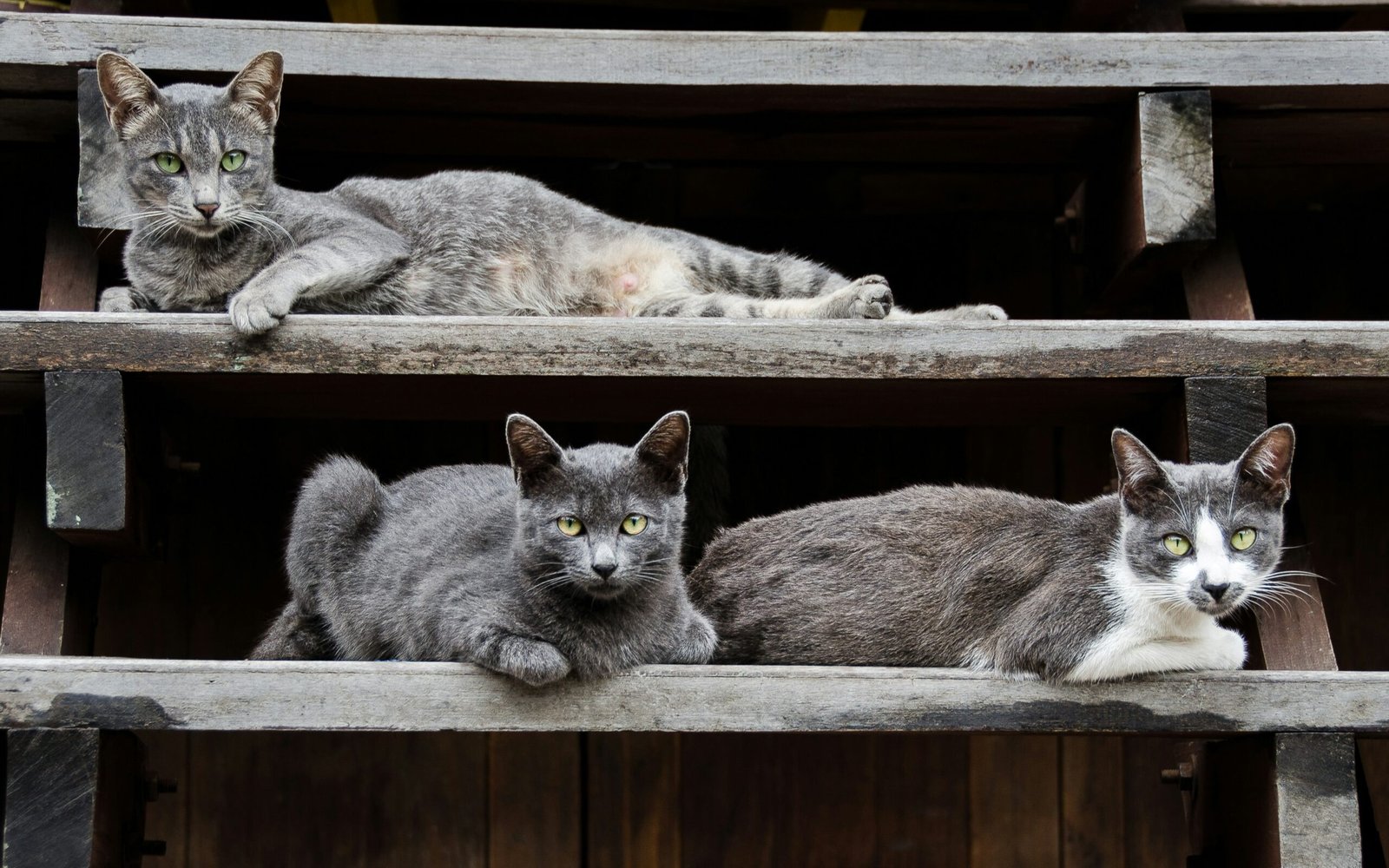Introduction to Purring
Purring is a fascinating vocalization primarily associated with domestic cats, although some wild species also exhibit this behavior. It is characterized by a continuous, low-frequency sound that occurs during both inhalation and exhalation, making it distinct from other vocalizations such as meowing and hissing. While many cat owners may recognize purring as a sign of contentment or affection, it serves a more complex range of purposes that reflect the emotional and physical states of the animal.
Research suggests that purring can act as a form of communication not only between cats but also with humans. The sound is often produced when cats are in a relaxed state, such as while resting or being petted, creating an association with comfort and safety. However, purring is not solely linked to positive experiences; it can also occur when a cat is in distress, injured, or anxious. This duality highlights the intricate nature of feline communication and emphasizes the importance of context in interpreting a cat’s behavior.
The prevalence of purring is notable among domestic cats, with estimates suggesting that nearly all domestic felines engage in this behavior as part of their vocal repertoire. While many wild cats may not purr in the same manner as their domestic counterparts, several species, including cheetahs and bobcats, exhibit similar vocalizations, suggesting that the ability to purr may have evolved in various ways across the feline family. Understanding this phenomenon will unveil the broader implications of purring beyond a simple expression of happiness, leading to a richer understanding of a cat’s emotional landscape.
The Anatomy of Purring
Purring is a characteristic sound produced by cats, often associated with their contentment and relaxation. Understanding the biological mechanisms that underpin this phenomenon requires an exploration of several anatomical components, particularly the larynx, the brain, and the sound production mechanisms. The structure of a cat’s larynx is uniquely adapted for producing the distinctive purring sound. Within the larynx are two vocal cords that can vibrate rapidly, generating the soothing sound that many cat owners recognize and enjoy.
Initiation of purring begins in the brain. Specifically, the neural oscillators located in the cat’s brain send signals to the muscles surrounding the larynx, causing them to twitch at a frequency between 25 and 150 vibrations per second. This rapid contraction and relaxation of the muscles result in the alternation of the opening and closing of the vocal cords. The precise coordination between the brain and the laryngeal muscles creates the rhythmic and continuous sound of purring.
In addition to the muscular and neural components, the physical structure of the cat’s throat also contributes to the richness of the purring sound. When a cat inhales and exhales, the flow of air causes the vocal cords to vibrate, producing sound both during inhalation and exhalation. This bi-directional sound production not only distinguishes purring from other vocalizations but also allows for an almost constant soothing sound that can be heard when a cat is at rest. The evolutionary significance of this complex anatomical system remains a topic of research, yet it is evident that purring serves various functions—from communication with their owners to self-soothing during times of stress or pain.
Purring as a Communication Tool
Purring is a multifaceted vocalization that serves as an important communication tool for cats. While it is often associated with feelings of contentment, purring can also express a range of emotions and needs in various contexts. For instance, when a cat is relaxed and happy, the soft, rhythmic purring may be an indication of enjoyment, signaling to both other cats and humans that they feel safe and comfortable in their environment.
However, the communication of purring extends beyond moments of joy. Cats may also purr during times of stress, anxiety, or even pain, showcasing the complexity of their vocalizations. In such cases, the sound may act as a self-soothing mechanism, helping the cat to alleviate discomfort or fear. This adaptive response suggests that purring functions not only as a signal to other cats but also as a method of coping with difficult situations.
Moreover, the context in which a cat purrs can reveal much about its emotional state. For example, an anxious cat may employ purring to calm itself while navigating a stressful environment, such as during a visit to the veterinarian. In contrast, a mother cat may purr to reassure her kittens, reinforcing their bond and providing comfort. This nurturing aspect of purring illustrates its role in fostering communication between cats and enhancing their social interactions.
Additionally, purring can facilitate communication with humans, bridging the gap between species. Many cat owners observe that their pets often purr when they seek attention or affection. By understanding the different circumstances under which cats purr, humans can attune themselves more closely to their feline companions’ needs, forging deeper connections and enhancing the human-animal bond.
The Therapeutic Effects of Purring
The soothing sound of a cat’s purr has captivated many, and recent studies have shed light on its potential health benefits for both felines and humans. The frequency of a cat’s purr typically ranges between 25 to 150 Hertz, a range that has been linked with various healing properties. Research suggests that these specific frequencies may promote tissue regeneration and help reduce pain, making the act of purring a remarkable natural phenomenon.
One of the primary benefits attributed to cat purring is its ability to lower stress levels. Studies indicate that the calming sound can help alleviate anxiety in humans, creating a serene atmosphere conducive to relaxation. By simply petting a purring cat, individuals may experience a significant reduction in stress as the rhythmic vibrations resonate both emotionally and physically. This can lead to lower levels of cortisol, a hormone associated with stress, which in turn promotes a more tranquil state of mind.
Additionally, the therapeutic effects of purring extend to physical health. The vibrations produced by a cat’s purr can stimulate healing processes in bones and muscles, making it beneficial for recovering pets and their owners alike. For humans, exposure to these frequencies has been linked to improved blood circulation and decreased blood pressure. Such wellness effects can enhance mood and lead to a sense of overall well-being.
Furthermore, the comfort provided by a purring cat creates emotional bonding moments that contribute to heart health. Studies have shown that petting a cat and listening to its purr can lead to feelings of companionship and support. This emotional connection not only enriches the human-animal bond but also fosters an environment that promotes healing and happiness, showcasing how the humble purr of a cat plays a vital role in enhancing health and well-being.
Purring in Kittens vs. Adult Cats
Purring is a fascinating behavior observed in both kittens and adult cats, yet the reasons behind this vocalization differ significantly between the two stages of a cat’s life. Kittens begin to purr as early as a few days after birth, primarily as a form of communication with their mother. This early purring plays a crucial role in the bonding process, signaling the mother’s presence and her young’s well-being. The soft vibrations emanating from a kitten’s body not only reassure the mother that her offspring is content but also help to strengthen their emotional connection.
As kittens grow and experience the world around them, their purring behavior continues to evolve. While still a communication tool, it increasingly becomes associated with comfort and security, often employed during moments of pleasure or relaxation. The frequency and intensity of purring in kittens can vary, reflecting their emotional state and the context in which they are purring. It serves as a mechanism for both soothing themselves and engaging with their littermates.
In contrast, adult cats exhibit purring behavior that can serve a wider range of purposes. While adult cats still purr when content and comfortable, such as when they are being petted or resting, this vocalization may also arise in situations of stress or discomfort. The soothing vibrations can help mitigate pain or anxiety, thus showcasing the adaptive nature of purring in adult cats. Additionally, adult cats utilize purring as a means of social interaction, often within bonding scenarios that occur between them and their human companions or fellow felines.
Overall, the significance of purring in kittens versus adult cats illustrates the development of social behaviors and emotional communication throughout a cat’s life. This evolution underscores the complexity of feline vocalizations and their essential role in fostering bonds, whether in the initial stages of life or within the adult context.
Purring Mechanisms Across Species
Purring is predominantly associated with domestic cats, yet it can also be found in various other feline species and even certain non-feline animals. Examining these similarities and differences illuminates the biological significance of this behavior. Domestic cats produce a purring sound through rapid contraction and relaxation of the muscles within the larynx, combined with the rhythmic movement of the diaphragm, creating a soothing resonance that can vary in frequency and intensity.
Interestingly, big cats such as cheetahs and cougars exhibit different purring mechanisms compared to their domestic counterparts. For instance, while cheetahs can purr as a form of communication, they primarily use it during prolonged exhalation, often when they are relaxed or content. This differs from the continuous purring of domestic cats, which can occur both during inhalation and exhalation. Cougars, on the other hand, also possess the capability to purr, although they usually reserve this behavior for specific contexts, such as when they are with their young or in a relaxed state.
Beyond the feline family, some non-feline species exhibit purring-like vocalizations. For example, various species of mammals, such as certain rodents and even some primates, have been observed to produce similar sounds, typically associated with comfort and social bonding. Although these sounds may not match the physiological attributes of purring in cats, they serve analogous purposes, enhancing social cohesion within groups and fostering tranquility among individuals.
This comparative exploration of purring mechanisms emphasizes the multifaceted nature of this behavior across different species. While the specific physiological processes may vary, the underlying functions of communication, relaxation, and social bonding remain consistently significant. Understanding these similarities helps clarify why the enigmatic purring of cats continues to fascinate both scientists and pet owners alike.
The Mysteries of Purring: Questions and Theories
Purring is a unique behavior exhibited by felines, yet its purpose remains a subject of much debate among researchers and cat enthusiasts alike. While it is commonly associated with contentment, various theories suggest that purring may serve multiple functions. One prominent theory posits that purring acts as a form of communication between cats and their owners, as well as a mechanism to soothe themselves during stressful situations. This notion raises questions about the emotional states of cats when they purr and whether the sound holds different meanings in varying contexts.
Another theory suggests that purring may promote healing and recovery. Research has shown that the vibrations produced by a purr fall within a specific frequency range (between 25 and 150 Hertz) known to promote tissue regeneration and reduce pain. This intriguing hypothesis could explain why cats often purr when injured or unwell. Nevertheless, further investigation is necessary to substantiate this claim, as the connection between purring and physical wellness remains largely uncharted territory.
The evolutionary origins of purring also spark considerable interest. Some scientists propose that purring could be a vestigial behavior inherited from ancestral felines, serving as an essential survival mechanism during nursing or conveying to the mother that the kitten is content and safe. However, the specifics regarding the evolutionary timeline of this behavior are still not fully understood.
Furthermore, the diversity in purring among different species of felids adds another layer of complexity to the issue. For instance, while domestic cats and some small wild cats can purr continuously, larger cats such as lions and tigers are generally unable to do so. This raises questions about how this peculiar behavior has evolved among various species and its implications for their social structures.
In light of these theories, ongoing research continues to explore the multifaceted nature of purring, shedding light on the unanswered questions surrounding this captivating feline behavior. As scientists strive to uncover the mysteries of why cats purr, our understanding of the complexities of their emotional and physical states will inevitably deepen.
Caring for an Over-Purring Cat
Caring for a cat that purrs excessively can be a unique challenge for pet owners. Purring is often associated with contentment; however, an unusually high frequency of this behavior may suggest underlying issues that warrant attention. It is essential for owners to observe their cat’s overall behavior and health before drawing conclusions about the cause of excessive purring.
The first step in assessing your cat’s purring is to monitor the context in which it occurs. If your cat is purring while lounging and appears relaxed, it is likely an expression of happiness or comfort. Conversely, if the purring occurs alongside signs of stress, such as hiding, aggression, or loss of appetite, it may indicate anxiety or discomfort. Keeping a log of your cat’s behavior can help identify patterns and possible triggers.
If the excessive purring is accompanied by other concerning symptoms, such as changes in eating habits, lethargy, or unusual vocalizations, it is advisable to consult a veterinarian. These symptoms could suggest underlying health issues, ranging from dental problems to more serious conditions like hyperthyroidism or respiratory illnesses. Early intervention can be crucial in managing health-related problems in cats.
To mitigate excessive purring, regardless of its cause, ensure your cat has a stimulating environment. Engage them with interactive toys, provide scratching posts, and spend quality time playing together. A structured routine can significantly reduce anxiety and help your feline friend feel secure. Additionally, consider creating a safe space where your cat can retreat if they feel overwhelmed.
In conclusion, while purring is typically a sign of a content cat, excessive purring may hint at a need for attention. By observing behavior patterns, consulting a veterinarian when necessary, and ensuring a stimulating home environment, owners can effectively address the needs of their over-purring felines.
Conclusion: Embracing the Purr
In exploring the diverse reasons behind why cats purr, it becomes evident that this behavior is much more than a simple expression of contentment. Purring serves various functions in a cat’s life, encompassing communication, self-soothing, and social bonding. Cats often purr when they are relaxed, such as during moments of affection and interaction with their human companions. However, it is equally important to recognize that purring can occur during times of stress or discomfort, making it a versatile behavior that reflects their emotional state.
The multifaceted nature of purring highlights the complexity of feline communication. When analyzing the context in which a cat purrs, owners can gain insights into their pet’s feelings and needs. Moreover, understanding that purring can also denote pain or distress underscores the responsibility of cat owners to monitor their pets closely and seek veterinary attention when necessary. This underscores the bond of trust between a cat and its owner, reinforcing the notion of companionship as an integral aspect of caring for a pet.
Ultimately, it is essential to embrace the purr as a significant part of the feline experience. Appreciating this behavior not only enhances the relationship between cats and their owners but also fosters a deeper understanding of the needs and emotions of these beloved pets. As pet enthusiasts gain insights into the reasons behind why cats purr, they can create a nurturing environment that promotes their overall well-being. Thus, the purr, in all its complexities, should be celebrated as a beautiful aspect of our feline friends, enriching both their lives and ours.



